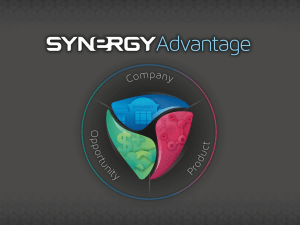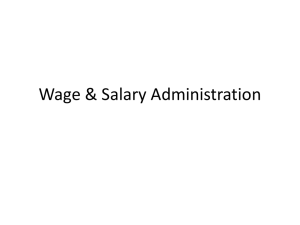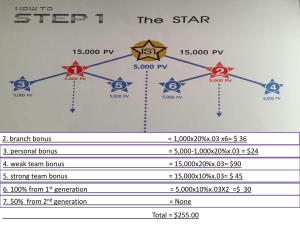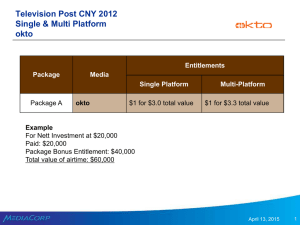Incentives - Portal Rasmi PLWS
advertisement
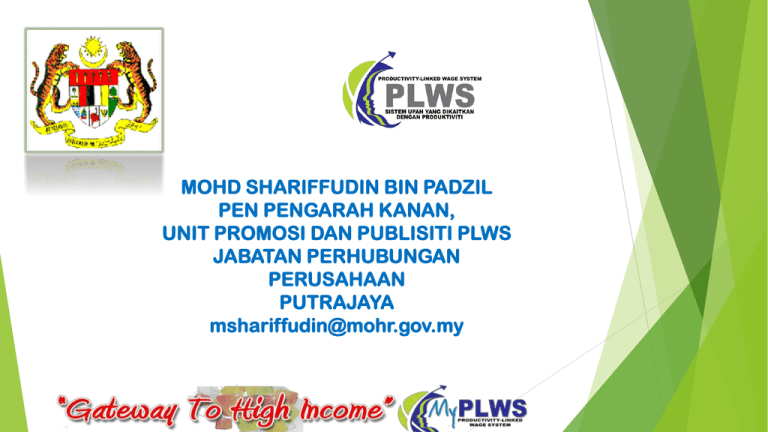
MOHD SHARIFFUDIN BIN PADZIL PEN PENGARAH KANAN, UNIT PROMOSI DAN PUBLISITI PLWS JABATAN PERHUBUNGAN PERUSAHAAN PUTRAJAYA mshariffudin@mohr.gov.my CONTENTS Concept High Income Economy Concept Productivity Productivity Linked Wages System Examples Model of PLWS HIGH INCOME ECONOMY Income per capita usd 15k – 20k 2020 PRODUCTIVITY GROWTH MUST BE AT LEAST 4.5% - 6 % PER ANNUM CONSISTENTLY 2014 Malaysia’ Productivity And GDP Growth New Economic Model (NEM) ♦ Creating a high income nation will mean higher wages throughout the economy. ♦ Allow wage level to be reflective of the skill level High Income Economy ♦ Raise wage through productivity gains. ♦ Protect workers through stronger safety net while encouraging labour market flexibility ♦ Encourage higher productivity activities and pave the way for more robust future increase in wages CONCEPT PRODUCTIVITY • Productivity is the ability to produce output from a given set of inputs ~ measures the efficiency and effectiveness of resource utilizations such as employees, technology, system and management etc., in converting inputs into useful outputs. • Mathematically, PRODUCTIVITY = OUTPUT INPUT Output End-product of the process which can either be the finished goods or the services rendered. Gross Domestic Product (GDP) Total Output Added Value Monetary Value of Production Quantity of physical unit produced Input The amount of resources that are utilise in producing the goods or in providing the services. Employees Total man-hours worked Labor cost Capital/Fixed assets Energy Material Services PRODUCTIVITY LINKED WAGE SYSTEM IN MALAYSIA Malaysia’s Policies on Linking Wages To Productivity Guidelines on Wage Reform Was Established in August 1996. Establish a closer link between wages and productivity Develop a wider and systematic approach towards improving productivity and wages Ensure active involvement and cooperation of employees to develop PLWS Ensure that employees obtain a fair share of gains from productivity growth and performance improvements PRODUCTIVITY LINKED WAGE SYSTEM PLWS is a wage system which establishes a link between wages and productivity/performance. PLWS ensure any increase in wages commensurate with increase in productivity/performance PLWS enables employees to obtain a fair share of gains that arise from productivity growth and performance improvements. PLWS in Malaysia INDUSTRIAL RELATIONS DEPARTMENT (IRD) PROMOTE PLWS As of APRIL 2014 76,858 employers implemented PLWS BENEFITING 3,104,038 employees throughout Malaysia Key Players in PLWS Employer – the main player that will initiate the implementation of PLWS at company level. Employee (unionised or non-unionised) – is the main catalyst that will ensure that the KPIs set under the PLWS are achieved. Government – assists companies in developing the system and negotiation process. Linking wages to productivity makes the following possible: a) Higher wages for worker and higher profits for companies. b) Greater competitiveness for companies. Wages Profits Output Wages Profits Output 2 BASIC COMPONENTS OF PLWS FIXED COMPONENT • Basic salary • Annual Increment • Bonus Contractual ( if any ) There must always be the Fixed and the Variable component in the PLWS VARIABLE COMPONENT • Wage increase for the year is based on a productivity or • profit sharing formula ELEMENTS PLWS NON CONTRACTUAL BONUS INCREMENT BASE ON PERFORMANCE SERVICE CHARGES PIECE RATE SYSTEM INDIVIDUAL ACHIEVEMENT ATTENDANCE ALLOWANCE TRIP INCENTIVE SALES INCENTIVE COACHING / TEACHING ALLOWANCE MODEL PLWS 3 BASIC MODELS COMBINED MODEL PRODUCTIVITY MODEL PROFITABILITY MODEL PRODUCTIVITY MODEL FIXED COMPONENT Basic Wage & Annual Increment VARIABLE COMPONENT A variable productivity payment to be determined. T= A+P Where T = total wage increase A = annual increment P = variable productivity payment Example Productivity model • Year 1 • If Basic wage = RM1000 per month, A = 2% and P = 3%, • Basic wage + A = RM1,000 + 2% (RM1,000) = RM1,020 (built into basic wage). • • P = 3% x RM1000 x 12 months = RM360 per annum Year 2: • If basic wage = RM1,020; A = 2% and P = 4% • Basic Wage + Annual Increment = RM1,020 + 2% (RM1,020) = RM1,040 per month • P = 4% x RM1,020 x 12 months = RM489.60 per annum • Annual Variable Payment at end of year 2: • P for year 1 RM360.00 • P for year 2 RM489.60 • Cumulative for 2 consecutive years RM849.60 Example Profitability Model Fixed component Variable component • Basic Wages • Annual Increment • Bonus Contractual (if any) • bonus to be determined by a profit-sharing formula and where applicable:• The formula is to be agreed upon between the management and union and spelt out in the Collective Agreement or through consultation for the non-unionised sector PLWS Model 1: Profitability Model #1 • Payment of bonus according to profit levels based on monthly basic pay. Profit After Tax (RM Million) <1.5 (threshold) Bonus [Month(s)Salary] 0 1.5 - 1.99 0.5 2.0 - 2.49 1.0 2.5 - 2.99 1.5 3.0 and above 2.0 PLWS Model 3: Combine Model #1 • Payment of bonus according to 2 criteria – Company Performance and Employee Performance Rating Operating Profits (RM Million) Above 5.00 1.00 1.00 1.25 1.50 1.75 2.00 4.00 – 5.00 0.75 0.75 1.00 1.25 1.50 1.75 3.00 – 4.00 0.5 0.5 0.75 1.00 1.25 1.50 2.00 – 3.00 0.25 0.25 0.5 0.75 1.00 1.25 Below 1.00 0 0 0.25 0.5 0.75 1.00 <40 40 - 49 50 - 59 60 - 69 70 - 79 >80 Employee Performance Rating (%) Variable Productivity payment (Months) Combined Model #2 Annual Profit (RM Million) Months of Basic wage Above 1.49 1.00 1.00 1.25 1.50 1.75 2.00 1.00 – 1.49 0.75 0.75 1.00 1.25 1.50 1.75 0.77 – 0.99 0.50 0.50 0.75 1.00 1.25 1.50 0.50 – 0.69 0.25 0.25 0.50 0.75 1.00 1.25 Below 0.50 0.0 0.0 0.25 0.50 0.75 1.00 Productivity growth <1 1.0 – 2.49 2.5 – 4.99 5.0 - 7.45 7.5 – 9.99 >10.0 Examples Model PLWS Example 1 Performance and Productivity Incentives Incentives based on performance and productivity refers to reward system that linked variable pay or incentives to the performance or productivity of the employees. The incentives will vary according to the achievement of the employees . The firm implement wages system which comprises fixed and variable components. Under the fixed component the company gives basic pay and minimum annual increment based on not less than 2/3 or 60 % of 3 years CPI average. The increment will provide element of income stability and form a small portion of the wage bill to meet escalating living cost. The variable components comprises annual performance increment, annual performance bonus, monthly productivity payment and monthly multi skill allowance. The variable components will determine the total take home pay and the incentives will be based on performance and less efficient will receive lower returns. Incentive Based on Performance and Productivity Wage System Fixed Components Basic Pay Wage Min. Annual Increment Variable Components Profitability Productivity Incentives Combined Example of profitability Incentives The bonus will be paid when the company makes certain amount of profit that falls within a predetermined range. Table Profitability Incentives Profits After Tax (RM Million) Monthly Payroll Cost Bonus = Profit After Tax (RM Million) Monthly Payroll Cost Less than 5 5 0 5 5 1month 6 5 1.2 month 7 5 1.4 month 8 5 1.6 month 9 5 1.8 month 10 5 2.0 month ii) Productivity Incentives The incentives will based on team and individual performance against predetermine productivity measurement. Diagram: Productivity Incentives Productivity Based on team and individual performance against predetermined productivity measurement • Total output • Quality output • Wastages • Customer Satisfaction • Individual Performance Matrix incentives Matrix incentives will be given based on the profitability and average performance of division, department and individual as shown below. Profits (RM million) Incentives (Months) Less 5 0 0.1 0.3 0.5 5- 7 0.1 0.3 0.5 0.7 7-9 0.2 0.5 0.7 1.0 9-11 0.3 0.7 1.0 1.3 11-13 0.4 1.0 1.5 2.0 13-15 0.5 1.5 2.0 3.0 Average Performanc e (%) Less 70 70 -80 80-90 90-100 If the company performance are as follows: Division Performance is 85% Department Performance is 90% Individual Performance is 85% Average Performance of an employee is 86.7% Based on the calculation above the respective employee will received 2 months bonus if the company makes RM 13 million profits .The incentives taking into consideration the overall employees performance. In order to received higher quantum of bonus each employees should contribute to the division and department performance as well as their own performance. EXAMPLE 2 Profitability-linked bonus Fixed Bonus: The Company shall pay an annual guaranteed bonus equivalent to one month of the last drawn basic salary. Variable Bonus: Should the company make a profit of: RM1,500,000/= to RM2,500,000/=, the company shall pay one and a half (1.5) months of the last drawn basic salary as bonus; Profits exceeding RM2,500,000/=, bonus payment shall be two (2) months of the last drawn basic salary. Notwithstanding the above, the guaranteed bonus of one month, based on last drawn basic salary, shall continue to be applicable. EXAMPLE 3 Profit Sharing and Team Incentive There are two components in this model, the fixed and variable components. The Fixed Component comprises: •Basic Wage The basic wage comprises the monthly wage which is based on a salary scale with a minimum and maximum range for each category of employee. •Annual Increment The annual increment is linked to the basic wage and will vary within the scale of pay assigned to the position. Variable Component There are two types of incentives which are linked to productivity/performance: • Bonus Based on Profit and Individual Performance • Team Incentive Bonus Based on Profit and Individual Performance • The profit used in this model is Profit Before Tax which will be distributed to employees based on profit level and performance. The higher the firm’s profitability, the larger will be the amount available for sharing. • Table below shows an example the matrix system of bonus payment. Based on this matrix, the amount of bonus payment received by an employee will depend on the profitability of the firm and employee performance. Profit (RM million) Variable Incentive Bonus (Months) > 12 0 0.3 0.5 1.0 1.1 2.1 9-12 0 0.2 0.3 0.9 1.0 1.5 6-8.9 0 0.0 0.2 0.8 0.9 1.3 4-5.9 0 0.0 0.1 0.7 0.8 1.1 <4 0 0.0 0.0 0.5 0.6 0.9 Employee Performance Rating (%) <40 40-49 50-59 60-69 70-80 >80 Team Incentive Performance Criteria Performance Standard (Target) 1. Production targets above 80% 2. Quality output above 90% 3. Customer complaint Zero complaint 4. Maintenance No machine breakdown 5. Discipline No reminder or warning letter Team Incentive Payout based on Criteria Achieved Monthly Incentives Number of Criteria Achieved Incentives 5 RM 100 4 RM 80 3 RM 60 2 RM 0 1 RM 0 • If a team of 5 employees are able to achieve all the five criteria, each team member will receive RM 100 as a monthly incentive. • However, if the team achieves only 2 criteria then there will be no pay out. EXAMPLE 4 Productivity Targets In the case of this example, the service organisation gives incentives based on the productivity targets achieved. Table below shows an example of planned targets against achievable targets. Planned Target Actual Achievements Incentives (RM) 80% Above 100% 150 80% 91%-100% 100 80% 80% - 90% 50 80% Below 80% 0 Incentives are given to the employees when the actual productivity achievement is higher than the planned target. For example, if the planned target is 80% and the actual achievement is 95% then the employees will receive RM100.00 for achieving the productivity targets. EXAMPLE 5 Bonus Based on Company and Individual Performance The manufacturing firm in this example shall pay performance bonus based on the company and the individual performance. The company performance shall be based on achievements against business plan of the year and employee performance shall be based on the performance appraisal rating and points awarded in accordance to their annual appraisal Bonus Based on Company and Individual Performance Company Performance below 85% - 101% - 121% - Above Based on Business Plan 85% 100% 120% 140% 140% Individual Performance Bonus Payout Unsatisfactory below 40% 0 0.1 0.2 0.3 0.4 Average 40% - 54% 0.3 0.4 0.5 0.6 0.7 Good 55% - 69% 0.5 0.7 0.9 1.1 1.3 Very Good 70% -85% 0.7 1.0 1.3 1.6 1.9 Outstanding above 85% 1.0 1.3 1.6 1.9 2.2 If the company’s performance rating is 100% and individual performance is 75% which is “very good”, then the quantum of bonus that will be granted to the employee will be 1.0 month. Therefore, this clearly indicates that whenever both parties i.e. employees and firm perform very well, there will be higher quantum of bonus distributed among the employees. EXAMPLE 7 Debt Incentive Collection Debt Collection Current 30 days 60 days 90 days <RM100,000 2.0% 1.5% 1.0% 0.5% RM100,000200,000 1.0% 0.5% 0.25% 0.1% >RM200,00 0.5% 0.25% 0.1% 0.05% EXAMPLE 8 Rework Incentives Incentives will be paid when there is reduction in rework rate. Planned Rework 10% of the monthly output 10% of the monthly output 10% of the monthly output 10% of the monthly output 10% of the monthly output Actual Achievements Incentives (RM)* > 11% 0 8%-10% 10.00 5%-7% 15.00 2%-4% 20.00 0-1% 25.00 EXAMPLE 9 MERIT AND PROFIT SHARING SCHEME The Scheme consist of two components: (a) Fixed Component which comprises of basic wage plus an annual increment of 3%of basic salary and an annual bonus of one month’s basic salary. (b) Variable Component. Among the tools used to determine the variable component are profit sharing and personal performance review (PPR). EXAMPLE 10 • Performance Incentives Allowance The company decided to reward employees which already reach their maximum salary. Employees who have reached the maximum on their salary scale and have performed commendably during the period of review, shall be eligible for a monthly allowance for the next 12 month. Performance Incentives Allowances shall include the following category of performance as shown in table below. Performance Category Monthly Allowance Highly Effective RM 60.00 Competence RM 40.00 PLWS and its impact Companies with PLWS Elements in Collective Agreements Impact of PLWS Implementation Productivity Staff Turnover Absenteeism Rejects and Reworks 2001 - 2004 2005 - 2008 691 1,566 2006 (%) 2008 (%) 2.64 5.21 8.80 5.33 5.17 2.13 4.17 2.85 ENHANCE PLWS PRACTICES Improved Productivity and Competitiveness at the firm level Job stability and reduces retrenchment Provide continuous improvement Benefits Motivation and job satisfaction Improves communication and cooperation 44 THANKS YOU Further Information please logon to The Portal My PLWS www.plws.gov.my




